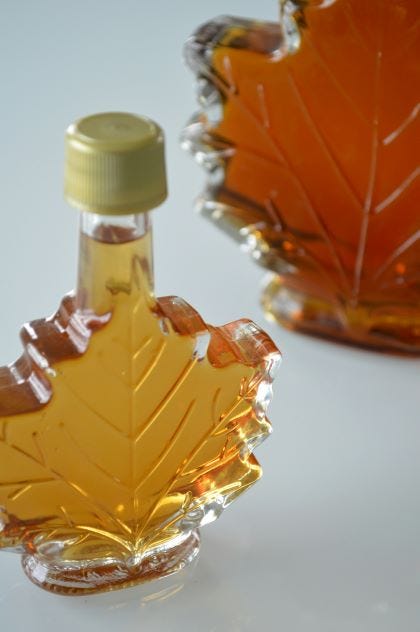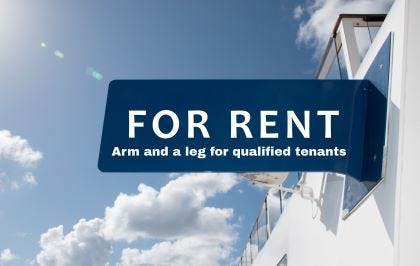1 Week, 7 Stories #19
Urban wildlife, wild pigs, and the wild world of rental housing.
Every edition features 7 stories, from the past week. I’ll draw on my background in media, journalism, agriculture, biotech, and renewable energy to come up with an interesting selection and do my best to offer some context.
Sometimes built around a theme, sometimes random, but with a Canadian twist.

Canada has its icons. Caribou. The beaver. Our politeness. And maple syrup.
We are driving the caribou to extinction, beaver habitat is being chewed up, and we are arguably a little less civil than our reputation suggests. Now climate change is starting to slow the flow of our maple syrup. The taps are running dry on our golden gold.
Every spring as temperatures start to rise and the sap starts to move in maple trees there is a 4 to 6-week window to collect the sap without harming the tree. The sap is boiled down to become maple syrup. It takes about 40 litres of sap to make 1 litre of syrup for your table. However a warm winter has shortened the time frame for collecting the sap. Last year’s production overall for the country was down 40%, the reserves in Quebec are falling, and the trend is continuing for 2024. Nova Scotia is offering crop insurance to producers, but that doesn’t increase the supply. To expand the industry and the supply, making Crown land available to maple syrup production is one option that has been successful in New Brunswick (now Canada’s 2nd largest producer behind Quebec) and is being considered in Ontario. While the supply situation is moving in the wrong direction Canada is still able to provide about 75% of the global demand, which dropped post-pandemic. How valuable is that demand? Just remember the great Canadian maple syrup heist.
About as Canadian as maple syrup is the love it or hate it dish, poutine. It is turning 60 this year and far from ready to retire. Even though “La Poutine Week” was in January, a syndicated article this week by Dalhousie University researcher and professor Sylvain Charlebois has fired the dish up on search engines. (though interestingly “Vladimir Poutine” also appears in those searches. I’m sure he will not be amused)
Poutine is definitely not a health food dish with a 254gm serving coming in at nearly 900 calories, and loaded with fats and sodium – depending on the recipe of course and whether you asked for extra gravy or cheese curds. Jamie Oliver called it the unofficial dish of Canada back in 2014 and the BBC said only Quebec can claim to be the home of the gooey mixture of French fries covered in cheese curds and gravy. It has been the subject of a children’s book, is on lists of things to do in Quebec, and is definitely a comfort food.
So to my university alumni friends who I still hoist a beer with on a regular basis, I must remind you that 82% of Canadians would “definitely” or “probably” eat poutine, which makes our little group at least representative of the country.
Home rental costs continue to go up and the supply continues to fall behind demand. It has become a landlord’s market and some wanna-be property tycoons are taking advantage of the situation. Pleading that ‘costs are going up’, anecdotal evidence suggests that 50 to 100 percent increases are not uncommon even though inflation sits at 2.8%. That makes it tough for the 5 million Canadians who rent and makes it Christmas in landlord land. Across Canada the asking rental price has climbed 21% from two years ago.
In Quebec the situation is hitting seniors hard, especially in Montreal where more than half of the residents – many of them seniors – are renters. Bill 198 finally moved past the first reading in the National Assembly thanks to pressure from tenants’ groups. The Bill would ensure that long-term tenants 65 or older on low incomes could not be evicted. In the federal budget expected in mid-April, the Prime Minister said this week that there would be help for renters which would include a new “bill of rights”. The immediate reaction form Quebec? No. Initial reaction across the rest of the country to the idea (there is no draft of the proposal for anyone to see) reflects the split between tenant and property representatives. While actually owning a home is out of reach for many Canadians, the recognition that we need more rental units and that renters need some protection could result in a shift by investors towards creating a stable rental market.
I don’t have to do much more than step outside my front door to see jack rabbits, coyotes are a common site in a nearby park, and a natural city park within a 10-minute drive has lots of deer. Skunks hang out under the steps of a fourplex less than a block away, and the occasional porcupine has been known to pass through on its way to who knows where. Sometimes though, urban wildlife can get out of hand as in the case of the deer population in Montreal’s Pointe-aux-Prairies nature park. The park is easily accessible to Montreal residents and is not too far from an oil refinery and an electrical substation. The white-tailed deer are used to people and even though it is not allowed, can be fed by hand. But with no natural predators the deer are growing in numbers and ruining their own habitat. Options to control and reduce the population have been explored, but politicians are wary of becoming known as the ones being responsible for culling (aka killing) the cute and friendly animals with big brown eyes.
While these deer are tipping the scale in terms of impact and numbers, they are just one example of the growing prevalence of urban wildlife. As our cities expand, they encroach on wildlife habitat. Many animals keep moving further out but there is a limit to the land available for them to call home. Other animals thrive and become part of a new urban ecosystem. A peer-reviewed study published this week adds in another factor. Climate change will lead to the elimination of some urban wildlife and new species will move in to become your neighbours. Whether that becomes a net increase or decrease remains to be seen but it does mean a change in how city folks relate to the wildlife shift over the next decade or so. A relationship many people have still not figured out how to handle. We’ll need to change our attitude and our approach to urban planning. Creating wildlife corridors and green spaces can become part of the planning process and as individuals there are things we can do to live with the creatures that were here first or who decide to join the urban lifestyle.
Have some fun and learn something in the process as well. There is still enough snow on the ground to see and identify the tracks you see in your favourite park!
Wild boar are defined as either a feral Eurasian wild boar or a domestic pig/Eurasian wild boar hybrid. They were imported to Canada from Europe beginning in the 1970’s as part of efforts to diversify livestock production. Escaped and now feral animals are prolific breeders, damage fences, uproot crops, and have been referred to as “ecological train wreck”. Alberta said this week its ‘sounder’ trapping incentive will come to an end this week. (A sounder is the collective name for a group of the pigs by the way.) However the overall “Squeal on Pigs” program has been effective in controlling the wild population which is also a problem in other parts of the world. Texas for instance is home to an estimated 3 million wild pigs, they have been seen in Rome nosing into handbags, and there are an estimated 3,000 of them in Berlin. A BBC story this week on the “boisterous, destructive, and divisive” pig however harkens back to our previous story on urban wildlife and coexistence. The main difference between what is found in North America and what is roaming around Europe is that over here they are an invasive, introduced species. In Canada a sounder of pigs is seen to uproot crops and destroy vegetation whereas in parts of the UK it is seen as mixing plant layers and encouraging biodiversity.
As one ecologist said in the BBC story, "We need a new management blueprint".
Video of the ship that crashed into the bridge in Baltimore looked like something out of a disaster movie. I’m sure you have been reading or seeing numerous stories about the crash and the search for victims, but beyond the immediate event we are getting a glimpse into the global supply and transportation network. You only have to think back to 2021 when the Ever Given cargo ship ran aground in the Suez Canal and stopped marine traffic for six days. The container vessel Dali that is now blocking the 11th largest US port was headed for Sri Lanka. Because of the threat of Houthi attacks along its usual route through the Red Sea, the Dali was going to take a much longer route around the tip of the Africa adding at least 10 days to the trip. That means a more expensive voyage, and guess who is going to pay for that. Consumers. Home Depot, Ikea, and Amazon import through Baltimore and 444,000 cruise ship passengers pass through the terminal. The Port of Baltimore normally handles more than 52.3 million tons of international cargo every year ranging from cars to fossil fuel products to coal. Those little packets of sugar you get in a coffee shop? Chances are it went through Baltimore before coming to Canada. We know how shortages hit us at the height of the pandemic and the fragility of the Red Sea route has been a problem for months now. This latest incident will make things worse because not only will it take some time to re-open the port to marine traffic, truck and rail alternatives will be slower, more expensive, and strained beyond capacity. Sea routes move 80% of good traded globally and each time one of the main hubs or routes are disrupted, the effects reverberate around the world. Parts become unavailable to manufacturers which slows production lines, oil shipments are bogged down, construction material delays hurt housing starts, and the inflationary cycle is kicked up a notch. The system can and does adapt, but there is a cost to us all.
I’m available for contract and freelance work with not-for-profits and charities. With 40 years of experience behind me and lots of time ahead of me, I’m here to help you make a difference in your media relations, public relations, and general communications needs.


